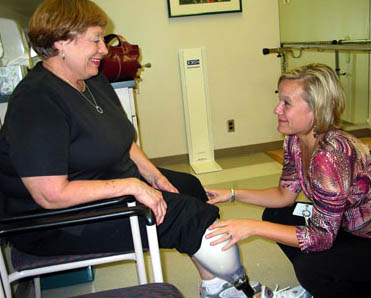RAYMOND, Miss.—Carol Anderson is careful to spell out w-a-l-k when she’s around her Rat Terrier, Brussels Griffon and two Chihuahuas. She doesn’t want to get their hopes up yet.
But the day is near when she’ll once again take Lucy, Sadie, Emma and Annie on a romp around her Raymond neighborhood. After years of being hobbled by a severely injured ankle, Anderson is reclaiming her active lifestyle with the help of an artificial limb.
Anderson, a division order manager for Pruet Companies in Jackson, said her troubles began with a 1981 accident. “A log truck turned in front of our pickup and I had time to put my foot on the dashboard to brace myself,” she said. “That was a huge mistake. My ankle joint totally came out and my foot was on the side of my leg.”
Surgery and physical therapy initially got Anderson walking again. But post-traumatic arthritis and several failed surgeries ultimately saddled the 62-year-old with a non-functioning foot. “It was basically an attached amputated foot,” said co-worker Brenda Biard. “She was walking on her leg bone and her foot was off to the side. She was in absolute agony, but she didn’t complain. She would just put on a happy face and come to work every day.”
As the pain worsened and she wound up on a rolling walker, Anderson learned she had three choices: Live with the pain. Undergo another surgery and deal with metal sticking out of her leg for six months. Or have her foot amputated.
After much prayer, Anderson chose the amputation. “It was the hardest thing I’ve ever had to do,” she said. “People who lose a limb in car accidents don’t have time to fret about what is going to happen. But I had weeks to worry. I was so emotional, all I did was cry for a month.”
At the heart of Anderson’s distress was a fear of the unknown. She had no inkling what to expect until Randy James, a partner at Pruet and a board member for Methodist Rehabilitation Center in Jackson, intervened. “He said: ‘I don’t want to influence you, but I wish you would talk to Methodist Rehab about a prosthesis because they are the best,’” she said.
“I felt she needed some questions answered because she was unfamiliar with what was ahead of her,” James said. “She’s a very dedicated, loyal employee and everyone in the company wants the best for her.”
Methodist Orthotics and Prosthetics manager Jennifer Long met with Anderson to address her concerns. And Anderson said it was reassuring to learn her anxieties were normal. “I would cry like a baby and Jennifer would say: Sweetheart, that’s OK,” Anderson said. “I spent two hours with her and she showed me the clinic and where they made the prostheses. She was really helpful and very informative.”
Long said pre-amputation counseling is a good way to confront emotional issues associated with the surgery. “Everyone has to go through a grief process,” Long said. “It helps when you can tell people it’s OK to cry about it.”
The chance to learn about equipment and the fitting process also teaches prosthetic patients how to become consumer advocates for the best care, Long said.
“People need to know that Mississippi doesn’t require prosthetists to be licensed, so not everyone that makes and sells artificial limbs undergoes the proper training and certification,” Long said. “There are companies that actually look for houses with wheelchair ramps and stake them out. The customer in those cases usually winds up with a poorly fitted prosthesis and no support from the seller. In contrast, our certified staff sits down with every patient to determine their needs before we recommend equipment and start the fitting process.”
“We don’t just hand them a product and say: There you go,” adds Methodist Rehab prosthetist Joe Moss. “First, we craft a temporary limb socket out of advanced plastics and give the patient time to try it out. Their feedback allows us to fine-tune the fit before we create a permanent carbon fiber model.”
It was Moss who fashioned Anderson’s new leg, and he and Long still marvel at how quickly she adjusted to the limb. “They said I was the first person who walked out with just a cane,” Anderson said. “Usually people use a walker or two canes.”
Anderson credits her stellar performance to plain stubbornness. “I am a very determined person. When I decide I am going to do something I put every bit of strength into trying to do it.”
“She’s one of the toughest people I know,” Biard said. “The day after surgery I went to see her and expected her to be laid up in bed and she was sitting up like nothing had happened. It blew me away.”
Anderson said she couldn’t have come so far without the support of friends, family and co-workers. “And I have a very strong faith,” she said. “I think that helps a lot.”
Biard said when her friend seemed most afraid, she suggested that she look to the future and all the things she would be able to do again. “She loves to work in the yard and she used to have beautiful daylilies.”
And there’s a good chance those flowers will be back in bloom come summer. Anderson can’t wait to get back to all the activities that fell by the wayside after her foot injury. “My main goal is to be able to walk my four puppy dogs,” she said. “We used to walk two miles a day before my foot got so painful.”


